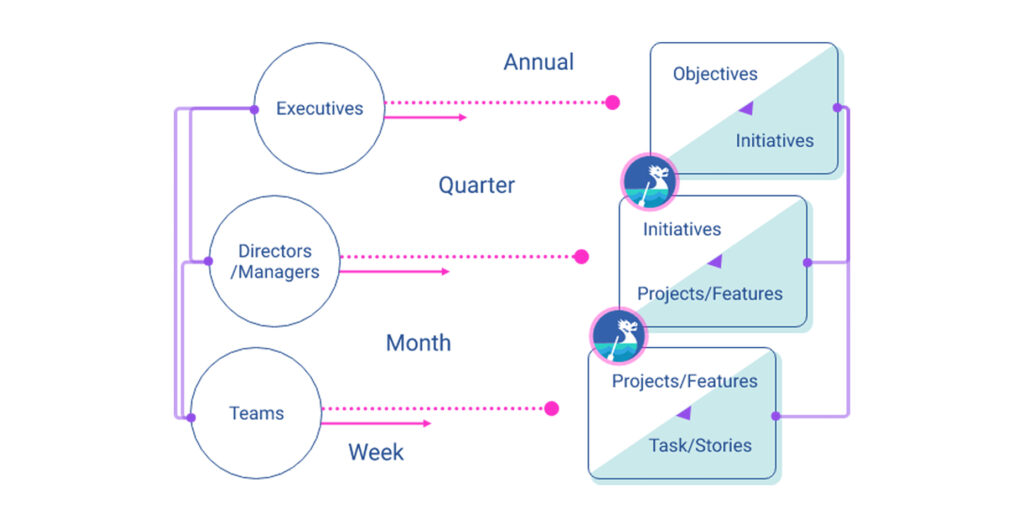When it comes to setting product OKRs (objectives and key results), there are several rules of thumb that most who are familiar with this goal framework already follow. For example, objectives should be aspirational enough to motivate team members, and key results shouldn’t be easy targets. When used correctly, a product-led company can use goal-setting frameworks like OKRs to accelerate outcomes by enabling top-down alignment, bottom-up innovation, and cross-functional collaboration.
Let’s dive into some mistakes that go beyond the obvious dos and don’ts of setting product OKRs that even the most well-intentioned organizations make when rolling them out.
Are Your OKRs Connected to Product Initiatives?
It’s typical for companies to implement OKRs by starting from the top and breaking big goals into smaller pieces for each level of the organization to own, which creates a waterfall effect or “cascading OKRs.” Each step of the way down, the scope gets smaller and the underlying assumption is that each of the smaller scopes stacked together will achieve the higher goal.
While that sounds nice and cut-and-dry, in reality, things are not as straightforward. Here are some of the main reasons why cascading OKRs are impractical:
- Most companies have teams that work cross-functionally on multiple initiatives (more on that later in this post)
- When teams focus on their own goals, they become siloed and disincentivized to help others achieve their goals
- Through a top-down command and control management style, they stifle bottom-up innovation and promote micromanagement
To overcome these challenges, rather than breaking down goals into the different hierarchy levels and assigning them to specific people or teams, break down goals based on various initiatives that can help support the outcome.
Let’s look at an example. For a company-wide OKR, such as “double revenue,” the initiatives should be cross-functional, allowing multiple teams to work towards the same goal. For instance, an initiative at an ed-tech company could be “Launch teacher taskforce” for which marketing could focus on new messaging & leads for teachers, sales on increasing conversion, and product on getting teachers to value faster to boost retention.

Learn more about how product teams can connect OKRs with product initiatives to empower teams and how to switch from feature roadmapping to OKR roadmaps.
How Do Your Initiatives Impact Other Teams?
It’s important to remember that everything’s balanced in business and while setting product OKRs, the law of cause and effect still applies! Say the marketing team wants to increase conversions, for example. It can do so by running different experiments that will impact other teams in different ways. This might include lowering the price, extending the free trial period, or reducing friction on the demo sign-up page.
While this might improve conversions, it could cause problems for other teams. For example, by eliminating some of the fields in the demo request form, the conversion rate will improve, but at the same time, it will generate more work for the sales team. Now, they have to spend more of their precious time qualifying leads.
Remember to respect the balance and the importance of other teams’ goals and initiatives. Make sure you’re setting product OKRs that would not negatively impact others if you were to achieve them.
To make sure you set product OKRs that are not in competition with other areas, it’s imperative to have easy visibility and cross-team collaboration. For managers, this means being able to effectively create alignment by collaborating up, down, and sideways.
Are Your Goals Cross-Functional?
Since teams don’t live in a vacuum, it will always be true that multiple teams must come together to achieve different goals, which means roadmap dependencies will inevitably occur. It’s important to spot them, plan ahead, and keep track of them with a responsive product portfolio management platform.
So, to ensure cross-functional success, keep in mind these three things about setting product OKRs:
1. Prioritize amongst your different goals.
2. Allocate your resources to these goals.
3. Identify & plan dependencies across teams.
If you manage to do these three steps, everyone across the organization can agree on what should be the main focus at a given time and with what resources.
Do You Have Visibility Into Goal Progress?
One of the biggest telltale signs that your OKRs aren’t working is when individual contributors and managers don’t look at them as time goes by. Instead of a “set it and forget it” artifact, OKRs and any progress made towards them should be reviewed consistently and frequently using a responsive product portfolio management tool. Thus, the team can work in a way that is responsive to the business goals and changes in the market.
Similarly, it’s a mistake to only look at OKRs during performance reviews, relegating them to an HR activity. Team progress should be tracked in real-time so that if there needs to be strategy adjustment and re-allocation, it can be done before it’s too late. Outcome-focused product means multiple teams are contributing initiatives to achieve the objective. The allocation should therefore ebb and flow based on insights of what’s working and what’s not.
How Are You Balancing Short-Term Wins with Long-Term Focus?
Product teams must avoid the potentially fatal mistake of not thinking far ahead enough into the future. Striking the right balance between making progress on short-term and long-term goals (aka big bets) is what keeps companies competitive despite shifts in the market landscape and customer tastes. Remember what happened to Blockbuster when Netflix arrived on the scene? This is where strategic planning plays a critical role so that nothing important falls through the cracks.
One effective way to prioritize is the rock, pebble, and sand technique. Responsive product portfolio management follows this approach, but with its own adaptation. It incorporates multiple jars of varying sizes, recognizing that at any given time, product needs to support many goals, compete for the same resources, and allocate them accordingly.
Read more about the rock, pebble, and sand approach to product and portfolio management.
That wraps up some of the most common mistakes teams make when setting product OKRs. Can you think of some others? Let us know!




